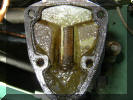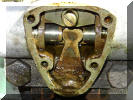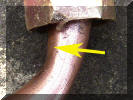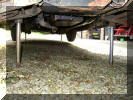|
End of Menu Items |
The Day of the Jackall
By Andrew Coulson
Returning from a most enjoyable and successful 'Y-type Register' tour of the North Yorkshire Dales, I was pleased with the way our 1951 YA had performed, but also a little embarrassed in one area!
The touring assembly (for details see reports elsewhere in this website and other esteemed motoring journals) had gathered at Reeth and had headquartered itself at The Kings Arms (c.1734) on the village green. Among the attractions here was the car parking in front of the hotel, on ancient cobbles. This had one plus; that any oil drips (and with an XPAG there is always an oil drip!) showed a maximum of one cobble-sized area (the excess being able to drain into the sand and finer particles of the bedding material) and one risk; that the visiting patrons would be continually asking questions (to which they would receive differing answers form each of the participants!).
A frequent question was about the set up of the Smith's Jackall system, integral to the Y types, usually triggered by spotting a device of unknown function under the bonnet (the distribution unit [more commonly called the Jackall pump]). As I had observed leakage of the hydraulic fluid from my system (or more correctly, my car's system) some months earlier, I had drained the reservoir and tried to locate the source of the leak. Cleaning and re-tightening the olive on the feed to the distribution unit had not remedied things, and I had reluctantly come to the conclusion that the inner seals were at fault. As a result, I was able to describe the system, but unable to put on the usual handle pumping demonstration for the interested parties.

 The enthusiasm generated by the Yorkshire Tour continued after arriving home and so I set about a detailed audit of the Jackall hydraulics. Having removed the cover (leaving the main mechanism in situ.) I was surprised by the jelly like mass that filled both the cover and the cylinder mechanism of the unit. Considering that there is no exposure of the fluid to other materials, the contents and consistency were unexpected. Both of these were cleaned thoroughly, the large seal cleaned and re-set, and the unit reassembled — and then filled. Horror of horrors, the copper pipe below the unit became wet with the greenish yellow of hydraulic fluid, despite carefully re-aligning and tightening the cover, the feed pipe and the transfer pipes.
The enthusiasm generated by the Yorkshire Tour continued after arriving home and so I set about a detailed audit of the Jackall hydraulics. Having removed the cover (leaving the main mechanism in situ.) I was surprised by the jelly like mass that filled both the cover and the cylinder mechanism of the unit. Considering that there is no exposure of the fluid to other materials, the contents and consistency were unexpected. Both of these were cleaned thoroughly, the large seal cleaned and re-set, and the unit reassembled — and then filled. Horror of horrors, the copper pipe below the unit became wet with the greenish yellow of hydraulic fluid, despite carefully re-aligning and tightening the cover, the feed pipe and the transfer pipes.
 At this stage, spurred on by the fine sunshine which was staying with us, my wife came out to inspect progress and was surprised to see the beads forming almost immediately after they were wiped away. What was also noticeable was that the actual base of the distribution unit was not wet, but the pipe showed fluid starting around 1 inch below this. It then dawned — and was confirmed by careful visual checking in bright light — that the pipe itself was defective and was allowing fluid out through a hairline crack.
At this stage, spurred on by the fine sunshine which was staying with us, my wife came out to inspect progress and was surprised to see the beads forming almost immediately after they were wiped away. What was also noticeable was that the actual base of the distribution unit was not wet, but the pipe showed fluid starting around 1 inch below this. It then dawned — and was confirmed by careful visual checking in bright light — that the pipe itself was defective and was allowing fluid out through a hairline crack.
Diagnosis now being definite, the question arose of what to do, and (not for the first time) I was thankful for the 'miscellaneous' spares which have been accumulated over the past seven years. As well as replacement distribution units and reservoirs I had located two pipes, one of which I have fitted to my YT, but one of which was 'spare' — if only I could find it in good order.
 Success was achieved with cleaning of a correctly olive ended pipe, re-bending to the needs of the YA topography and re-fitting to the cleaned and (hopefully) functioning reservoir and pump. A re-fill was in order, followed by testing of the rams (two front, two rear which can be lowered in either front or rear or combined mode in order to elevate the whole car). Having achieved lifting and retraction of the rams the car was then raised and left, under pressure for 15 minutes. At the end of which success was declared! But without anyone underneath it!
Success was achieved with cleaning of a correctly olive ended pipe, re-bending to the needs of the YA topography and re-fitting to the cleaned and (hopefully) functioning reservoir and pump. A re-fill was in order, followed by testing of the rams (two front, two rear which can be lowered in either front or rear or combined mode in order to elevate the whole car). Having achieved lifting and retraction of the rams the car was then raised and left, under pressure for 15 minutes. At the end of which success was declared! But without anyone underneath it!
As well as showing the contents of the base and cover of the distribution unit before cleaning, there is a close up of the defective pipe showing a hairline crack in the copper. Whilst common things (such as seal failure) are undoubtedly common, the lesson from this is to consider all the possibilities and arrive at a reasoned diagnosis before moving in for the repair — cleaning the pump will no doubt help, re-setting the seals will help, but not as much as replacing the burst pipe!
Note: Any opinions expressed are solely those of the author and do not necessarily reflect those of the International MG Y Type Register.

